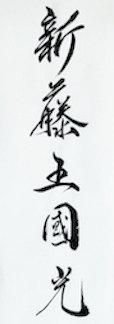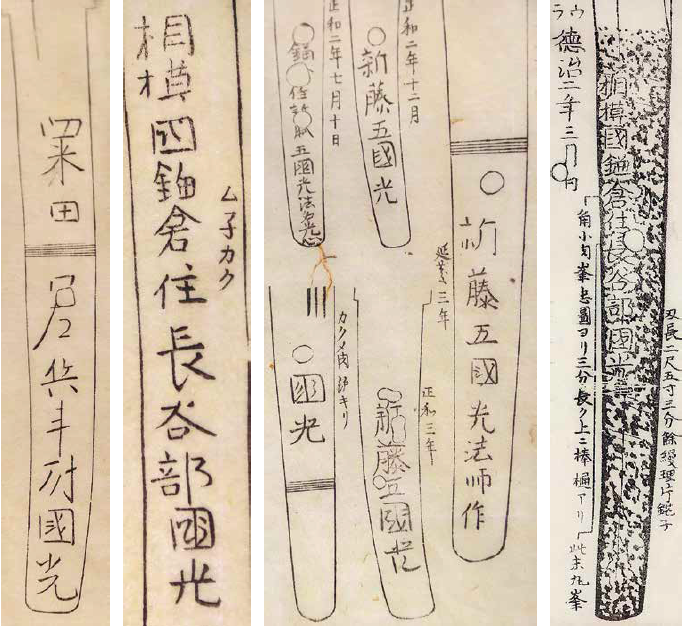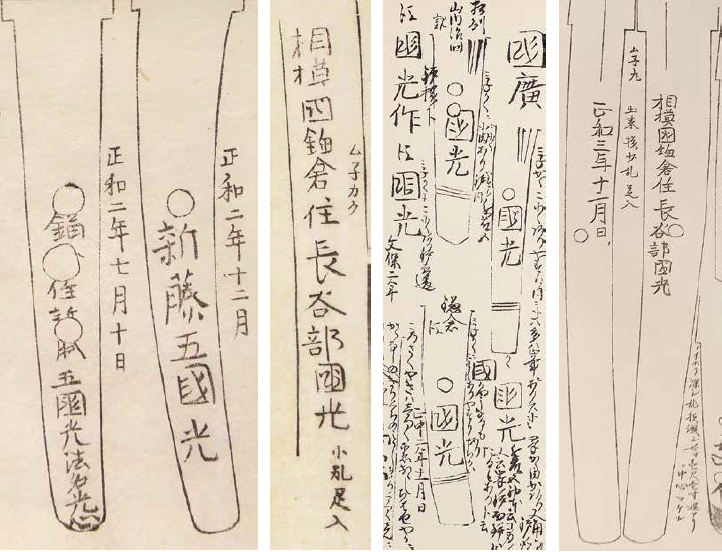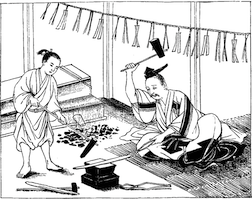
Shintōgo Kunimitsu (新藤五國光) is rightfully considered the founder of the Sagami School. He was famous not only as a great smithing master but also as a great teacher. There is still a lot of controversy regarding Shintōgo Kunimitsu’s origin, and many different theories attempt to explain it. One of the most common points of view in contemporary literature is that Kunimitsu was a son and a disciple of Awataguchi Kunitsuna (粟田口国綱光), and at birth, he was given the name Shintōgo (新藤五). However, we can find another variant of his name in other old sources: Shintōtarō (新藤太郎). His father, Awataguchi Kunitsuna (Tōrokurō— 藤六郎), was the second son of Awataguchi Kuniie (粟田口國家), and his works are tachi with a sugata typical for the middle Kamakura period, masame and a hoso-suguha (細直刃) hamon in ko-nie-deki.
The Ōseki Shō (reprint, 1978, p. 23) contains information stating that Shintōgo Kunimitsu lived in “Sōshū Yamanouchi Numa” (相州山内沼間).
Some sources draw our attention to the fact that hamon and horimono in works by Awataguchi Kunimitsu (Tōbei— 藤兵衛) are very similar to those in Shintōgo’s works, and they put forward an alternate theory of his origin. According to this theory, Awataguchi Kunimitsu (the second son of Norikuni) came to Kamakura and started working there under a new first name, having replaced his own with Shintōgo. For instance, the Honchō Kaji Kō, Volume Ox, p. 16/1, mentions that during the Kenchō era (建長, 1249–1256), this smith took the name of Shintōgo and kept working in Kamakura under this new name. This theory explains, in a very logical way, a violation of the tradition of transferring only one kanji in the smith’s name from the father to his son; in the case of Shintōgo, we can see that he completely repeated the name of his alleged father. This would have been possible if he continued the line of Awataguchi Kunimitsu as the second generation. However, this theory is likely to be wrong for the following two reasons:
First, there is quite a great difference between the skill levels of these two smiths. We can hardly imagine that moving to Kamakura immediately raised the level of Awataguchi Kunimitsu’s skill by a significant degree and, at the same time, changed his specialization from tachi to tantō. Second, if we assume that Shintōgo and Awataguchi Kunimitsu were one and the same smith, then Shintōgo’s supposed date of birth would be moved forward more than twenty years, which is unlikely, taking into account the dates of his later works. According to the Kotō Meizukushi Taizen (古刀銘盡大全), published in 1792, Awataguchi Kunimitsu was born in 1207 and died at the age of thirty-six in 1244. This date may not match other versions of his paternity (Shintōgo was allegedly born in 1250), but it can indirectly confirm the version that states he is one and the same smith. Taking into account a possible inaccuracy in the dates of old sources, we can confidently say the following: somewhereat the turn of the year 1250, one smith’s name disappeared (Awataguchi Kunimitsu), and another name appeared (Shintōgo Kunimitsu). Yet it is not known for certain which events this was connected with: the birth of a son or a change of name by the master himself.
Studying the works of Shintōgo Kunimitsu, we note that there is no unambiguous opinion about the origin of this master. The sources dating back to different periods describe his genealogical line in various ways. For example, the Shōwa Hon (a book of the Shōwa period, 1312–1317) tells us that his father was Saburō Kunimune (三郎國宗), whereas, according to other sources from the Edo period, his father was Awataguchi Kunitsuna (粟田口國綱). According to the information contained in the Tōken Kantei Hikketsu (Hon’ami Yasaburō, 1905, Volume 3 [6], p. 24), Kunimitsu was a son whom Kunitsuna fathered in his later years. After Kunitsuna’s death, Kunimitsu became a student and later the adopted son of Kunimune. It is said that Kunimitsu learned the art of engraving from Daishinbō.
The Kotō Meizukushi Taizen also states that the name of Shintōgo’s father was Awataguchi Kunitsuna, who was born in 1163 and died in 1255 (in his 93rd year). At the same time, this source tells us that Shintōgo Kunimitsu was born in the 2nd year of Kenchō (建長, i.e., in 1250) and died in his 63rd year in the first year of the Shōwa era (正和, i.e., in 1312), whereas during the Kōan era (弘安, 1278–1288), he was in his 29th year. His father died when he was six years old. His master Kunimune died when Kunimitsu was twenty-two years old. The information provided in the Kotō Meizukushi Taizen is sometimes contradictory and controversial and does not match the details in other sources. In particular, based on these dates, Kunitsuna’s son would have had to be born in 1250, when the father was eighty-seven years old, which does not seem plausible. In addition, we can note a clear discrepancy between the data in different sources as to the year when Kunitsuna came to Kamakura. According to some sources, he was invited there during the Kenchō era (1249–1256) by Regent Hōjō Tokiyori—that is, one year before his death, at a very old age. According to other sources, such as the aforementioned Kotō Meizukushi Taizen, he settled in Yamanouchi (山ノ内), in the Kamakura region, during the Shōji era (正治, 1199–1201), at the age of forty-two (we again note a small mathematical error in the dates, he would have been about thirty-seven years old). Surely, we should not completely rule out the possibility of such a course of events, but modern researchers do not agree with the dates provided in this source, shifting the dates of Kunitsuna’s life forward by twenty to twenty-five years, and we must admit there are reasons for this.

Figure 1. Oshigata Awataguchi Kunimitsu, Shintōgo Kunimitsu. Kotō Meizukushi Taizen, Volume 8, p. 5/1, p. 25/1, p. 22/1; Honchō Kaji Kō, 1795, Volume Boar, p. 5/2.
Because of these inconsistencies and the lack of exact data about who was the father of Shintōgo, it is difficult to determine the date of his birth and the name of his teacher. Most probably, his teacher was Awataguchi Kunitsuna; nevertheless, one theory states that Shintōgo’s and Masamune’s teacher was Saburō Kunimune. In numerous sources, we can find indications that initially, Shintōgo was taught the Bizen style, and that Kunimune was his teacher. The same Kotō Meizukushi Taizen contains information that in his 29th year, Shintōgo was trained by Kunimune in the year 1278. The dates of Kunimune’s life are specified as 1180–1270, however, with a mathematical error stating that his death occurred in his 94th year. With such inconsistencies, it is very difficult to unconditionally trust such a source as the Kotō Meizukushi Taizen. Surely, we cannot expect absolute accuracy in such books, because they tell us about events that took place many centuries ago. They were based on information from old scrolls, repeatedly rewritten and damaged here and there. Therefore, we must bear in mind the need to make small adjustments, and then that adjusted information can become extremely valuable and useful.

Figure 3. Kotō Meizukushi Taizen, Volume 8, p. 22/1 and p. 25/1; Ōseki Shō (reprint, 1978), p. 23; Kōzan Oshigata, Volume 乾, p. 55/2.
<......> Many old sources, such as the Kiami-bon Mei-zukushi (喜阿弥本銘尽) and the Kanchi-in Bon Mei Zukushi, tell us that it was Shintōgo Kunimitsu who taught Masamune the craft of sword making. Yet Masamune was not his only disciple. At that time, the group of “senior” disciples whom Shintōgo trained included Yukimitsu (行光), Masamune, and Norishige (則重), as well as his three sons: Kunishige (國重), Kunihiro (國廣), and Kuniyasu (國泰).
- Kunishige (國重)—Son of Kunimitsu, Shintōgo Tarō (太郎), born in the 8th year of Bun’ei (文永, 1271) and died in his 32nd year in the 1st year of Kengen (乾元, 1302);
- Kunihiro (國廣)—Son of Kunimitsu, Shintōgo Jirō (次郎), born in the 10th year of Bun’ei (文永, 1273) and died in his 44th year in the 1st year of Bunpō (文保, 1317); and
- Kuniyasu (國泰)—Son of Kunimitsu, Shintōgo Saburō (三郎), born in the 1st year of Kenji (建治, 1275) and died in his 64th year in the 4th year of Kenmu (建武, 1338).
What is more, all these masters experimented mainly during group training and work in Kamakura, influencing one another’s style and adopting the others’ best achievements. Thus, Shintōgo’s most frequently used method of hardening was suguha, whereas later, he made blades with a midare hardening. The latter were closer to Masamune’s, though some of Masamune’s blades had suguha hardening. It is believed that the first sword in the Sōshū style was forged by Shintōgo in approximately 1290.

It is necessary to note the following distinguishing characteristics of Shintōgo Kunimitsu’s works:
Sugata: In the main, his tantō are rather short (23–24 cm), with a narrow mihaba and a fukura that is kareru (膨枯れる, scarce) by type, and a subtle takenoko-zori (筍反り). The tachi-sugata is slender, has a high shinogi, a high mune, and a compact kissaki.
Jitetsu: A compact ko-mokume-hada of extremely high quality (it might be described as itame in Hon’ami books), with a very large number of chikei with the steel being blackish and having a bluish hue on top of it; sometimes, we can see a mix with a rather large amount of ō-hada. In the ji, there is a lot of nie, which look like golden nashiji, what is called nashiji-hada (梨子地肌); this effect can be compared to the “pure yellow sand at the bottom of a crystal stream.” An utsuri may appear that looks like a spider’s web.
Hamon: Mainly, there are different types of suguba—hoso-suguba or chū-suguba (sometimes, ito-suguba or hiro-suguba) on the basis of nie. There is only one tantō with midare-ba: the meitō “Midare Shintōgo.” Usually, the activity is greater in the area of ha than in the area of habuchi; in the tantō, where we can see a narrowing in the area of fukura, the play of different elements is especially beautiful here.
Bōshi: Mainly, ko-maru with an abundance of nie; in general, there is a tendency to increase the concentration of the nie along the ha-machi of the fukura.
Horimono: Very often, we see clearly cut horimono like suken, bonji, gomabashi, koshibi, and katanahi; the work features good style, elegance, and deep engravings. Blades without horimono can be rarely found.
Nakago: Mainly, long and straight; sometimes, it can be found in the form of furisode-gata, yasurime kiri, or katte-sagari.
Mei: The most typical signature is niji-mei, sometimes, followed by a date. “Kuni” kanji contains a mirrored “S” in the signature on the left, whereas the top part (the crown) of the “Mitsu” kanji is often written in the sōshotai style (the grassy, calligraphic style). The lower horizontal line of the tilting right leg ends with a small rising upstroke.
(excerpt from Chapter 3, pp. 42-57, of the Japanese Swords: Sōshū-den Masterpieces )
Original content Copyright © 2019 Dmitry Pechalov